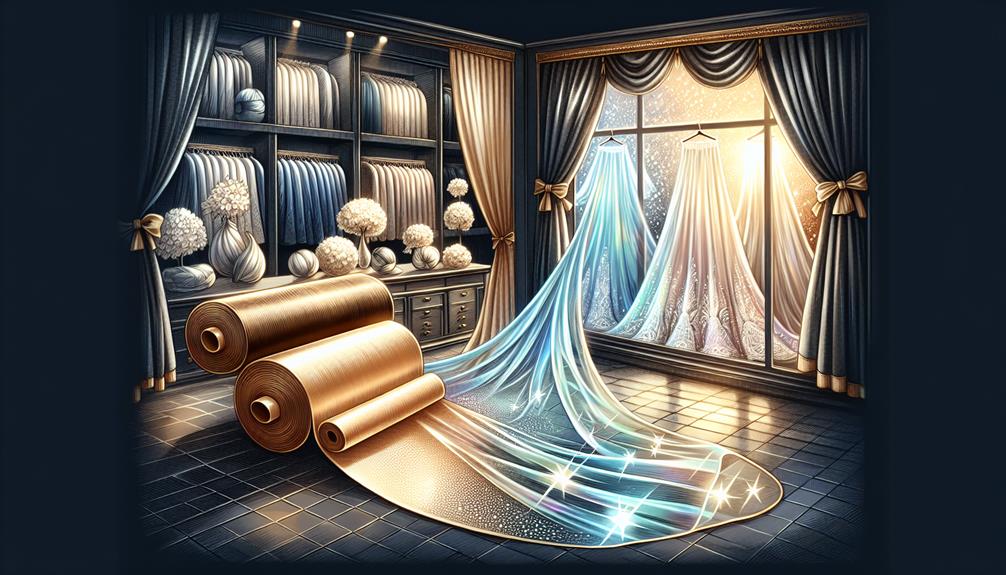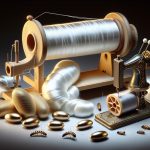I've always been curious about whether organza is more expensive than silk. From what I've found, silk usually costs more. This makes sense because producing silk is pretty labor-intensive; those silkworms aren't working for free, after all! Silk has that luxe feel and elegant drape, which often make it pricier. On the other hand, organza, which can be made from silk or synthetic fibers, tends to be cheaper when it's synthetic. So, if you're eyeing something in organza, the price might not hit your wallet as hard as silk would. There's definitely more to uncover about how these fabrics stack up.
Table of Contents
Key Takeaways
- Silk is typically more expensive than organza due to its labor-intensive production process.
- Organza can be made from synthetic fibers, which are cheaper than silk.
- The rarity and manual process of silk extraction contribute to its higher cost.
- Organza made from synthetic materials offers a similar aesthetic to silk at a lower price.
- While silk is valued for its luxurious feel and natural sheen, organza is prized for its stiffness and structure, impacting their respective costs.
Understanding Organza and Silk
To understand the cost difference, let's first explore what organza and silk are. Organza is a thin, plain weave fabric traditionally made from silk. Nowadays, you might also find organza made from synthetic fibers like polyester. It's known for its stiffness and sheen, making it a favorite for more structured garments.
Silk, on the other hand, comes from the cocoons of silkworms. It's a natural protein fiber. Because of its production process, it's often viewed as more luxurious and has a smoother feel compared to organza. Silk flows well and has a natural luster that's quite eye-catching.
So, when we're talking about these two, it's not just about the material itself but also about their characteristics. Organza, with its crisp texture, is great for adding volume and drama. Silk, with its softness and drape, excels in elegance and comfort.
Understanding these basics helps us grasp why one might be pricier than the other. Each fabric brings its own unique qualities to the table, which impacts its value and cost. But, let's remember, the price isn't just about the material; it's also about what you can do with it.
Factors Influencing Fabric Costs
Several factors impact the cost of fabrics like organza and silk. I've noticed that it's not just about the material itself, but a mix of market dynamics and other elements. Here's a quick breakdown that can give you a clearer picture:
- Demand and Popularity: If more people want it, it's usually pricier. Silk often has a high demand due to its luxurious status, which can drive up costs.
- Quality and Grade: Not all silk and organza are created equal. Higher quality often means higher prices. The grade of the fibers significantly influences the cost.
- Source of Raw Materials: Where the materials come from matters. Imported materials can add to the cost due to shipping and tariffs.
- Seasonal Variations: Prices can fluctuate depending on the time of year. For instance, if there's a shortage of silkworms, the price of silk might spike.
- Fashion Trends: When a fabric becomes trendy, it usually becomes more expensive. If organza features in a lot of high-fashion collections, you might see a price hike.
Understanding these factors helps us grasp why sometimes one might be more expensive than the other, or why prices change. It's all about the broader context!
Production Process and Availability
The production process and availability of fabrics like organza and silk significantly affect their market price. Let's break it down.
Silk's journey starts with silkworms, specifically the Bombyx mori. They feed on mulberry leaves until they spin their cocoons. It's a natural fiber, and that makes it more labor-intensive. Workers boil the cocoons, then unravel the silk threads. It's a delicate process, needing skilled hands. That's partly why silk is pricier.
Organza, on the other hand, can be made from silk or synthetic fibers like polyester. The process depends on the material used. Silk organza follows the silk-making route but is woven differently, giving it that sheer, lightweight texture. Synthetic organza is cheaper because it's man-made and easier to produce in large quantities.
Availability also swings the price. Silk is less common than synthetic materials. It's all about supply and demand. More available materials like polyester make synthetic organza widely accessible and less expensive.
Comparison of Uses and Benefits
Organza and silk each offer unique benefits that suit different uses in fashion and decor. Let's dive into how each fabric shines in its own right.
Silk, known for its luxurious softness, is a go-to for high-end garments. It drapes beautifully, making it perfect for flowing dresses and elegant blouses. Its natural protein structure not only gives it a smooth feel but also a subtle sheen that catches the light wonderfully.
On the other hand, organza is the star when you need structure. Its stiffness is ideal for creating volume in wedding dresses or theatrical costumes. Plus, it holds up well in humid conditions, unlike silk, which can wilt.
For those looking to master the art of fabric selection, understanding these differences is key. Here's a quick list to break it down:
- Silk:
- Luxuriously soft
- Excellent drapability
- Natural sheen
- Sensitive to moisture
- Organza:
- Stiff and structured
- Good in humidity
- Adds volume to outfits
Each fabric has its place, whether you're crafting a breezy summer look or an audacious bridal gown. Knowing which to choose can elevate your project from good to magnificent.
Price Analysis and Trends
Let's now examine how prices for silk and organza have evolved and what drives their cost differences. Silk has always been seen as a luxury, thanks to its complex production process. Silk worms are picky eaters, sticking mostly to mulberry leaves, and the silk extraction and weaving process is manual and time-intensive. This justifies its higher price tag.
Organza, on the other hand, is usually made from silk but can also come from synthetic fibers like polyester, which reduces its cost. The introduction of these cheaper materials means organza offers a similar aesthetic at a lower price. However, pure silk organza still leans on the expensive side, though typically not as pricey as high-quality silk fabric.
Over the years, the price of silk has seen a steady increase, influenced by labor costs and silk's status as a sought-after material in fashion and interior design. Organza prices are more volatile; they fluctuate based on the raw materials used. Synthetic organza is cheaper and has become more popular as a cost-effective alternative to silk organza.
Understanding these trends helps us grasp why silk generally costs more than organza, though quality and origin can blur these lines occasionally.
Frequently Asked Questions
Can Organza Be Dyed Easily Like Silk?
I've found that organza can be dyed, but it's not as straightforward as silk. The process often requires specific dyes and conditions to ensure the color takes well and remains vibrant.
Do Silk and Organza Have Similar Care Requirements?
As they say, "different strokes for different folks," silk and organza require different care. I've found silk needs gentle washing, while organza can handle a bit more roughness. They're not the same, care-wise.
How Do Organza and Silk React to Humidity?
I've noticed that silk absorbs moisture and can lose its shape in high humidity, while organza, being stiffer, holds up better but can still feel heavier as it absorbs some moisture.
Are Silk and Organza Hypoallergenic Fabrics?
Alas, both silk and organza are not fully hypoallergenic. They can irritate sensitive skin because they're processed with chemicals. It's wise to test if they bug you before making a big purchase.
Can Organza Hold Embroidery as Well as Silk?
I've found that organza can hold embroidery, but it's not as resilient as silk. Silk's denser weave supports detailed stitching better, making it superior for intricate designs in my embroidery projects.
- Is Organza More Expensive Than Silk? - April 23, 2024
- What Is Organza Vs Chiffon? - April 23, 2024
- What Kind of Fabric Is Organza? - April 23, 2024







